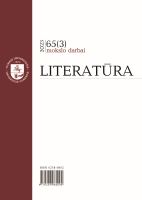Etnosimbolizmas kaip ankstyvųjų Naujųjų laikų raštijos tyrimo metodologija: teoriniai svarstymai apie XVI a. Lietuvos Didžiosios Kunigaikštystės politijos tapatumą
Ethnosymbolism as a Framework for Early Modern Literature Analysis: Theoretical Reflections on the Identity of the Political Community of the Grand Duchy of Lithuania
Author(s): Skirmantas KniežaSubject(s): Cultural history, Social history, Lithuanian Literature, Theory of Literature, Sociology of Literature
Published by: Vilniaus Universiteto Leidykla
Keywords: ethnosymbolism; nationalism; Grand Duchy of Lithuania; ethnicity; myth;
Summary/Abstract: The article aims to present historical ethnosymbolism as a theoretical alternative to the dominant modernist theories of nationalism. While the latter mainly focus on social factors and associate the emergence of nationalism with the industrialization of the 19th century, ethnosymbolists suggest evaluating cultural factors and interpreting the emergence of the modern nation as a chronological, continuous, and gradual process. The emergence of ethnosymbolism in the 1980s can be associated with a broader cultural turn in historiography and history studies: scholars shifted their focus to foundational myths and myths of descent, analyzing symbols that helped establish and cultivate the cultural memory of communities. Ethnosymbolist John Armstrong introduced concepts such as ‘mythomotheur’ and ‘myth-symbol complex,’ while Anthony D. Smith contributed to establishing the category of communal affiliation termed ‘ethnie’– a culturally coherent political community with a sense of solidarity among the higher strata of society. This community leverages ethnicity in a broader sense, including common history and name, myth of descent, and association with a certain territory, to maintain and strengthen their dominant position and independence. Examples from the literature of the 16th-century Grand Duchy of Lithuania (GDL) suggest that the myth of Roman descent, efforts to turn historical battles with Moscow and Ottomans into an epic, etymologization of Lithuania’s name, importance of the Jagiellonian dynasty, and other symbols helped cultivate historical subjectivity and a sense of identity among the nobility and intellectuals. While these insights should not imply proactive construction of nationhood, as Caspar Hirschi suggests in his study on the contemporary Holy Roman Empire, they indicate that the commonly employed term ‘political nation’ of the GDL can be further refined by reconsidering the contents of ethnicity, primarily dealing with the sense of historical identity and memory. This article argues that such a reading strategy can be used to uncover new layers in Early Modern literary texts, especially those related to cultural memory and political identity.
Journal: Literatūra
- Issue Year: 65/2023
- Issue No: 3
- Page Range: 35-49
- Page Count: 15
- Language: Lithuanian

